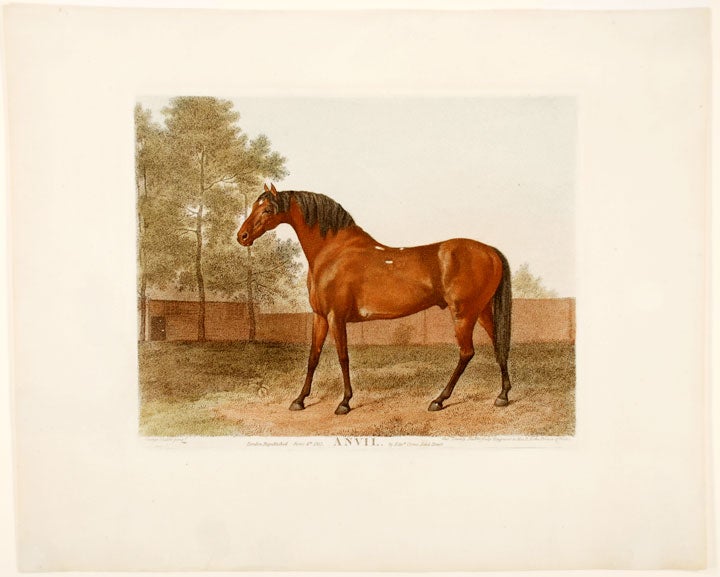STUBBS, George (1724-1806), engraved by George Townly STUBBS
Anvil
London: Published by Edward Orme, June 4th, 1817. Stipple with etching, colour-printed with hand-colouring. State iii/iii, with the title in closed letters, and engraved inscription: "George Stubbs pinxt.*** Geo. Townly Stubbs sculpt. Engraver to His R.H. the Prince of Wales. / London Republished June 4th. 1817, *** ANVIL. *** by Edwd. Orme, Bond Street" Sheet size: 12 1/2 x 15 5/16 inches. Plate mark: 7 7/8 x 9 7/8 inches.
A magnificent portrait of the famous stallion Anvil, by the master equine painter George Stubbs.
George Stubbs is considered to be one of the greatest English painters. His ingenious animal and sporting pictures remain unrivalled in their passionate depiction of emotion and their commitment to naturalistic observation. Stubbs was briefly apprenticed to the painter Hamlet Winstanley, a relationship that quickly ended, leaving the young artist to his own education. In contrast to contemporary academic theory, Stubbs' attached great importance to the belief that art should imitate nature, not the work of other artists. He spent years carefully studying human and equine anatomy so that he could truthfully represent natural form and movement. A result of this study was his famous Anatomy of the Horse, which details, with beautiful engraving, the various elements of a horse's anatomy, from skeletal form to muscular definition. By the 1760s, Stubbs had developed a considerable reputation as a sporting artist and had attracted a number of distinguished patrons. Continuing in search of innovation, Stubbs began experimenting with a myriad of different mediums, becoming accomplished in both enamels and printmaking. Through arduous application, he became a talented mezzotint engraver and worked with ease in both soft ground and etching techniques. Stubbs' masterful paintings inspired some of the greatest engravers of the day to reproduce his work for publication, including his own son George Townly Stubbs who reproduced with faithful accuracy the sublime emotion inherent in his father's exquisite works. Stubbs was elected Director of the Society of Artists and a Royal Academician, and today his prized paintings are housed in some of the finest museums in the world. Stubbs was often commissioned to paint accurate portraits of specific steeds for proud aristocratic patrons, who wished to highlight their horses' racing success. This practice is expertly exemplified with this magnificent print of the stallion Anvil, bred by Thomas Paton. The image shows Anvil in an enclosed paddock, and exhibits a keen attention to naturalistic detail. Anvil was first a stallion in the stud of the Prince of Wales and went on to win a great number of races at some of the best courses in England. This beautiful print demonstrates that, with subtle atmospheric effects and complex compositional structure, Stubbs succeeds in raising the genre of equine portraiture to a poetic level.
Lennox-Boyd, George Stubbs 114, ii/iii; Siltzer, The Story of British Sporting Prints, p. 272.
Item #19560
Price: $4,500.00


